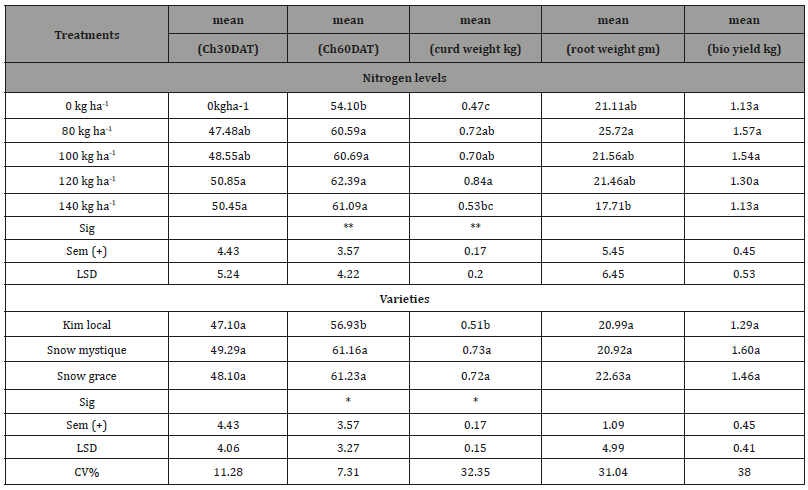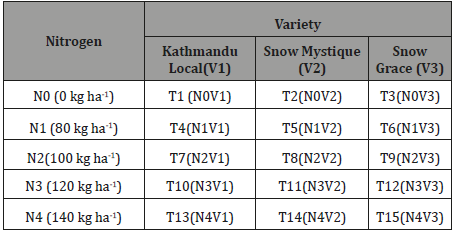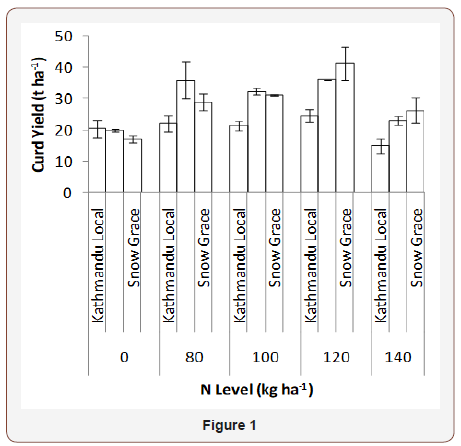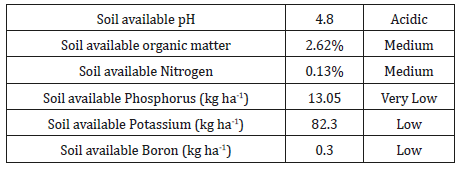 Research Article
Research Article
Performance of Different Varieties of Cauliflower (Brassica Oleracea Var. Botrytis) Under Different Level of Nitrogen Application in Ultisols of Lamjung Nepal
N Dhakal*, RK Shrestha, S Subedi, BKC and D Burlakoti
Department of Soil science, Institute of Agriculture and Animal Science, Nepal
N Dhakal, Department of Soil science, Institute of Agriculture and Animal Science, Nepal.
Received Date:September 03, 2018; Published Date: January 03, 2019
Abstract
Nitrogen (N) is one of the major determining nutrients for growth and development of cauliflower (Brassica oleracea L. var. botrytis). N deficiency in cauliflower field is becoming a major problem in Nepal. Soil application of appropriate amount of N can be an effective way to increase the qualitative and quantitative growth parameter of cauliflower. A field experiment was carried out in ultisols at Sundarbazar ward no.7 Taarkutar village of Lamjung district Nepal, during September 2017 to February 2018 to assess the response of five level of soil application of nitrogen (0 kgha-1, 80 kgha-1, 100 kgha-1, 120 kgha-1 and 140 kgha-1) on three genotypes of cauliflower (Kathmandu local, Snow mystique and Snow grace). The experiment was laid out in Randomized Complete Block Design consisting of 15 treatments with 3 replications. Half dose of N with full dose of P, K and B were applied as basal dose and remaining dose of N were applied in two split doses at 30 DAT and 60 DAT and Molybdenum (75ppm) was applied in 3 split doses i.e. 20 DAT, 40DAT and 60 DAT. The effects were observed over leaf chlorophyll content (30DAT and 60 DAT), curd weight, root weight and total biological yield. The findings of this study showed that the soil application of N showed significant result at leaf chlorophyll content and curd weight of cauliflower. Highest amount of leaf chlorophyll content and highest curd weight (0.84kg) was recorded at 120kgha-1 nitrogen level as compared to other level of nitrogen and Snow mystique had significantly highest chlorophyll content and curd weight (0.73 kg) over other varieties of cauliflower.
Keywords: Biological yield; Cauliflower; Chlorophyll; Curd yield; Nitrogen
Introduction
Nitrogen is determining nutrients for growing of cauliflower and other brassica vegetables which affects quality and quantity of harvested Phyto mass [1-4]. Nitrogen is an essential element of all the amino acids in plant structures which are the building blocks of plant proteins, important in the growth and development of vital plant tissues, and cells like the cell membrane, helps to increase the overall biomass production, to increase in curd diameter, curd size. Chlorophyll being an organelle essential for carbohydrate formation by photosynthesis and a substance that gives the plant their green color, nitrogen is a component in it that aids in enhancing these features. Nitrogen is essential in plant processes such as photosynthesis. Thus, plants with sufficient nitrogen will experience high rates of photosynthesis and typically exhibit vigorous plant growth and development.
N deficiency in plant results in poor plant performance and yield losses, with the following symptoms [5-7] stunted plants as the cells remain small and their cell walls become thicker; visual yellowing of leaves known as chlorosis, old leaf are more affected; and, acceleration of the reproductive stage and senescence. Low supply of nitrogen can lead to delayed maturation, inhibited protein synthesis and high reduction of the yield [8-12]. Deficiency of nitrogen in cauliflower can prevent curd initiation [13]. This is because the leaf area development is restricted thus the plant cannot support generative growth. In The plants growing in nitrogen deficient conditions physiological disorders like “buttons” can occur.
The soil should be well fertile supplied with organic matter and well drained. It is sensitive to high acidity and the optimum pH should be in between 6.0 to 6.5 for cauliflower production [14,15]. The acidic soil and poor organic matter content of soil ultimately affects the crop growth and yield of the crop [16], because at low pH plant can’t utilizes the nutrient present in soil which is converted into unavailable form. Soils in tropical and subtropical regions undergo a natural acidification process due to intensive weathering and leaching under hot and humid climate conditions [17- 19]. Such type of soil is called ultisols. Ultisols have accumulated clay mineral in the B horizon. While generally low in natural fertility (basic cations, ca++, Mg++ and k+) and high in soil acidity (H+, Al+++). With the objectives of site specific nitrogen management in the ultisols in case of different variety and nitrogen doses this research was conducted. And it is null hypothesized that Effect of different level of nitrogen in different variety would not vary.
Materials and Methods
Sundarbazar-7 taarkutar Lamjung was selected to carried out this experiment which was 650m above sea level with longitude 84° 11’ - 84° 38’ E and latitude 28° 3’ – 28° 30’ N.
Table 1: Effect of different levels of nitrogen on cauliflower varieties chlorophyll content, curd weight, root length and yield.

Table 2: Combination of treatments.

Field experiment was conducted during September 2017 to January 2018 in RCBD with two factors consisting of 15 treatment combination with 3 Replications (Table 1). The seedlings were raised in poky house of lamjung campus. The two factors of our experiment were; 5 N levels (0 kgha-1, 80 kgha-1, 100kgha-1, 120kgha-1, 140 kgha-1), which was the main factor and 3 varieties (Kathmandu Local, snow mystique and snow grace) which was the sub factor. The soil sample of experimental site was analyzed for total N, available P, K, organic matter and soil pH (Table 2). The collected soil sample was sent to soil management directorate, Lalitpur for analysis.
Thirty day old seedlings were transplanted on 12 Oct 2017 (plot 1 m2, Spacing: 50 cm x 50 cm). Healthy and uniform sized seedling were selected for transplanting dead seedling were replaced by healthy one within a week. Intercultural operations were carried out at the time of urea top dressing.
Nutrient management
Recommended level of NPK according to the lab analysis were 100:120:100 kg NPK ha-1 and FYM 20ton ha-1. Half dose of N with full dose of P, K and B (2kgha-1) were applied as basal dose and remaining in two split doses at 30 DAT and 60 DAT. Molybdenum (75ppm) was applied in 3 split doses i.e. 20 DAT, 40DAT and 60 DAT.
The crops were regularly observed to note done the leaf chlorophyll content, curd initiation, compactness in different varieties at different N levels. Harvesting was done on January 2018.
The data was analyzed with the help of ANOVAs and DMRT/ Duncan’s test for mean separation using R (3.1.3) and figures Microsoft Excel 2010.
Result and Discussion
Leaf chlorophyll content
Leaf chlorophyll content was measured 30 day after transplantation and 60 day after transplantation.
In terms of Ch30DAT, which was statistically non-significant at different level of nitrogen although mean maximum value was observed at 120 kgha-1 nitrogen level (50.85). Ch30DAT value was statistically non-significant with different varieties although maximum value was recorded with the variety Snow mystique (49.29). Ch30DAT value was statistically similar this may be due to plant establishment phase, poor root growth immediately after transplantation.
In terms of Ch60DAT which was statistically highly significant (P<0.01) among five levels of nitrogen (0 kgha-1, 80 kgha-1, 100kgha-1, 120kgha-1 and 140kgha-1), and also there was significant differences among three different varieties of cauliflower (P<0.05). The mean chlorophyll 60DAT value was significantly higher for nitrogen level 120 kgha-1 (62.39) which was statistically at par with 140 kgha-1,120 kgha-1, and 80 kgha-1. Ch60DAT value was significantly inferior at nitrogen level 0 kgha-1.
In case of variety Ch60DAT value was statistically significant and maximum value was recorded with variety Snow grace (61.23) which was statistically at par with variety Snow mystique. Variety Kathmandu local was significantly inferior. Ch60DAT was highly significant this may be due to, direct effect of N on the vegetative development, chlorophyll formation. Supported by Ruiping Hang (2010) and Premraj Gocher et.al, (2017).
Curd weight
In terms of fresh curd weight, cauliflower varieties showed significant difference at different level of nitrogen application. There was significant difference (P<0.01) among five levels of nitrogen (0 kgha-1, 80 kgha-1, 100 kgha-1, 120 kgha-1 and 140 kgha-1) and also there was significant differences among three different varieties of cauliflower (P<0.05). Highest value of mean curd weight was recorded at 120 kgha-1 nitrogen level which was 0.84 kg which was statistically at par with 80 kgha-1 (0.72) and 100 kgha-1 (0.70). Curd weight at N level 140 kgha-1 was statistically at par with 80 kgha-1 and 100 kgha-1. And N level 0 kgha-1 was significantly inferior (Figure 1).

In case of variety, which was statistically significant highest value of curd weight was recorded with the variety Snow mystique (0.73) which was statistically similar with snow grace (0.72) and Kathmandu local variety was significantly inferior (0.51). Curd weight was highly significant because N has positive effect on the curd diameter, curd compactness and curd color. Further supported by Ruiping Hang (2010), Saimbhi et al. (1969), Natarajan Singh Khokhar et al (1970), Randhawa and Bhail (1976) and Roy (1981).
Root weight
In terms of root weight, cauliflower varieties didn’t show significant difference at different level of nitrogen application (Table 3). Although the mean maximum value of root weight was 25.72 gram which was recorded at nitrogen level 80 kgha-1. Among three different variety snow grace had highest value of mean root weight which was 22.63. Ultisols is low in pH and red in color. At pH 6.5 cauliflower performs better but pH of this field was 4.8 at low pH most of the nutrient including N becomes deficit that’s may adversely affect the root growth due to which root weight was statistically non-significant at different level of N with different variety. This report was further supported by Ruiping Hang (2010).
Table 3: chemical properties of sampled soil.

Biological weight
Biological weight was statistically non-significant, although mean maximum value was 1.57 kg which was recorded at nitrogen level 80 kgha-1. In case of variety (i.e. Kathmandu local, Snow mystique and snow grace) which was statistically non-significant although the mean maximum value was recorded with Snow mystique which was 1.60 kg. Biological weight was non-significant may be due to N has more effect on the development of curd.PH of our field was 4.8 which is highly acidic and these are the critical factors which controls yield to great extent in our experiment. Cauliflower is sensitive to high acidity and the optimum pH should be in between 6.0 to 6.5 for cauliflower production [20].
Conclusion and Outlook
The application of N enhances the leaf chlorophyll content, curd weight, root weight and biological yield. Nitrogen level 120 kgha-1 would be more effective although the government recommended level of nitrogen was 100 kgha-1. Snow mystique variety would be more suitable. Furthermore, research need to be repeated using wider levels of N and other cauliflower varieties.
Acknowledgement
None.
Conflict of Interest
No Conflict of Interest.
References
- Goodlass, G Rahn, C Shepherd, MA Chalmers, AG Seeney, FM (1997) The nitrogen requirement of vegetables: comparison of yield models and recommendation systems. The Journal of horticultural science 72(2): 239-254.
- Kirthisinghe JP (2006) A complete and balanced fertilizer recommendation based on a systemic approach for Cauliflower (Brassica oleracea L. Var. Botrytis). PhD thesis PGIA, University of Peradeniya, Peradeniya.
- Greenwood DJ, Hunt J (2006) Effect of nitrogen fertilizer on the nitrate contents of field vegetables grown in Britain. Journal of the Science of Food and Agriculture 37(4): 373-383.
- Lošák T, Hlušek J, Kráčmar S, Varga L (2008) The effect of nitrogen and sulphur fertilization on yield and quality of kohlrabi (Brassica oleracea, L). RevistaBrasileira De Ciencia Do Solo 32(3): 697-703.
- Barker AV, Pilbeam DJ (2015) Handbook of plant nutrition. CRC press.
- Chaudhary B (1997) Vegetables.National Book Trust. New Delhi, India. of Microbiology and Biotechnology 22: 73-79.
- Everaarts AP (1993) Strategies to improve the efficiency of nitrogen fertilizer use in the cultivation of Brassica vegetables.Acta Horticulturae 339: 161-173.
- Rahn CR, Paterson CD, Vaid Yanat Han LVV (1998) The use of measurements of soil mineral N in understanding the response of crops to fertilizer nitrogen in intensive cropping rotations. J Agric Sci 130(3): 345-356.
- Rahn CR (2000) Nitrogen and field production of vegetable crops. Acta Hortic 533: 361-370.
- Sorensen J (1999) Nitrogen effects on vegetable crop production and chemical composition. Acta Hortic 506: 41-50.
- Neeteson JJ, carton T (2001) The environmental impact of nitrogen in field vegetable production. Acta Hortic 563: 21-28.
- Dzida K, Ja Rosz Z, Mi Chałojć Z (2013) Effect of nitrogen fertilization on the yield and nutritive value of Beta vulgaris L. J Elem 17(1): 19-30.
- Atherton JC, Hand DJ, Williams CA (1987) Curd initiation in cauliflower (Brassica oleracea var. botrytis L.). P133-145. In: Atherton JC ed. Manipulation of flowering. London, UK: Butterworth.
- Flessa H, Ludig B, Heil B, Merbach W (2000) The origin of soil organic C, DOC, and soil respiration in the continuous maize cropping system of the longterm experiment “Eternal Rye” in Halle. J Plant Nutr Soil Sci 163: 157-163.
- Panda N (2009) Particular issues in plant production under acid soils.The Orissa scenario. Proceeding IPNI-OUAT-IPNI International Symposium, pp. 137-145.
- Pattanayak SK, Misra UK, Sarkar AK, Majumdar K (2011) Integrated Nutrient management for Groundnut and Red gram on acid soils in Odisha. Better Crops-South Asia 5(1): 8-10.
- Krug EC, Frink CR (1983) Acid rain on acid soil: A new perspective, Science 221(4610): 520–525.
- Adams F (1984) Soil Acidity and Liming, 2nd Edn., Am. Soc. Agron., Crop Sci. Soc. Am. and Soil Sci. Soc. Am., Madison, Wisconsin, USA.
- Ulrich B, Sumner ME (1991) Soil Acidity. Springer-Verlag, Berlin, Germany, pp. 1-219.
- Everaarts AP, De Moel CP, Van Noordwijk M (1996) The effect of nitrogen and the method of application on nitrogen uptake of cauliflower and on nitrogen in crop residues and soil at harvest. Netherlands J Agri Sci 44(1): 43-55.
-
N Dhakal, RK Shrestha, S Subedi, BKC, D Burlakoti. Performance of Different Varieties of Cauliflower (Brassica Oleracea Var. Botrytis) Under Different Level of Nitrogen Application in Ultisols of Lamjung Nepal. World J Agri & Soil Sci. 1(2): 2019. WJASS.MS.ID.000508.
-
Biological yield, Cauliflower, Chlorophyll, Curd yield, Nitrogen, Nutrient management, Leaf Chlorophyll content, curd weight, Root weight, Biological weight, Cauliflower varieties
-

This work is licensed under a Creative Commons Attribution-NonCommercial 4.0 International License.






